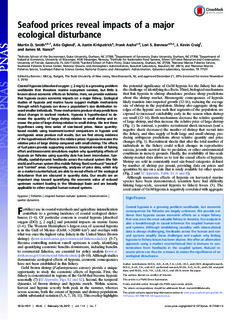| dc.contributor.author | Smith, Martin D. | |
| dc.contributor.author | Oglend, Atle | |
| dc.contributor.author | Kirkpatrick, A. Justin | |
| dc.contributor.author | Asche, Frank | |
| dc.contributor.author | Bennear, Lori S. | |
| dc.contributor.author | Craig, J. Kevin | |
| dc.contributor.author | Nance, James N. | |
| dc.date.accessioned | 2018-04-10T08:38:33Z | |
| dc.date.available | 2018-04-10T08:38:33Z | |
| dc.date.created | 2017-12-12T16:33:18Z | |
| dc.date.issued | 2017-01 | |
| dc.identifier.citation | Smith, M.D et al. (2017) Proceedings of the National Academy of Sciences of the United States of America. 114 (7), pp. 1512-1517. | nb_NO |
| dc.identifier.issn | 0027-8424 | |
| dc.identifier.uri | http://hdl.handle.net/11250/2493350 | |
| dc.description.abstract | Coastal hypoxia (dissolved oxygen ≤ 2 mg/L) is a growing problem worldwide that threatens marine ecosystem services, but little is known about economic effects on fisheries. Here, we provide evidence that hypoxia causes economic impacts on a major fishery. Ecological studies of hypoxia and marine fauna suggest multiple mechanisms through which hypoxia can skew a population’s size distribution toward smaller individuals. These mechanisms produce sharp predictions about changes in seafood markets. Hypoxia is hypothesized to decrease the quantity of large shrimp relative to small shrimp and increase the price of large shrimp relative to small shrimp. We test these hypotheses using time series of size-based prices. Naive quantity-based models using treatment/control comparisons in hypoxic and nonhypoxic areas produce null results, but we find strong evidence of the hypothesized effects in the relative prices: Hypoxia increases the relative price of large shrimp compared with small shrimp. The effects of fuel prices provide supporting evidence. Empirical models of fishing effort and bioeconomic simulations explain why quantifying effects of hypoxia on fisheries using quantity data has been inconclusive. Specifically, spatial-dynamic feedbacks across the natural system (the fish stock) and human system (the mobile fishing fleet) confound “treated” and “control” areas. Consequently, analyses of price data, which rely on a market counterfactual, are able to reveal effects of the ecological disturbance that are obscured in quantity data. Our results are an important step toward quantifying the economic value of reduced upstream nutrient loading in the Mississippi Basin and are broadly applicable to other coupled human-natural systems. | nb_NO |
| dc.language.iso | eng | nb_NO |
| dc.publisher | National Academy of Sciences | nb_NO |
| dc.subject | hypoksi | nb_NO |
| dc.subject | prisen på sjømat | nb_NO |
| dc.subject | fiskefarm | nb_NO |
| dc.subject | bioeconomics | nb_NO |
| dc.title | Seafood prices reveal impacts of a major ecological disturbance | nb_NO |
| dc.type | Journal article | nb_NO |
| dc.type | Peer reviewed | nb_NO |
| dc.description.version | publishedVersion | nb_NO |
| dc.subject.nsi | VDP::Samfunnsvitenskap: 200::Økonomi: 210 | nb_NO |
| dc.subject.nsi | VDP::Landbruks- og Fiskerifag: 900::Fiskerifag: 920 | nb_NO |
| dc.source.pagenumber | 1512-1517 | nb_NO |
| dc.source.volume | 114 | nb_NO |
| dc.source.journal | Proceedings of the National Academy of Sciences of the United States of America | nb_NO |
| dc.source.issue | 7 | nb_NO |
| dc.identifier.doi | 10.1073/pnas.1617948114 | |
| dc.identifier.cristin | 1526434 | |
| cristin.unitcode | 217,8,3,0 | |
| cristin.unitname | Institutt for industriell økonomi, risikostyring og planlegging | |
| cristin.ispublished | true | |
| cristin.fulltext | original | |
| cristin.qualitycode | 2 | |
